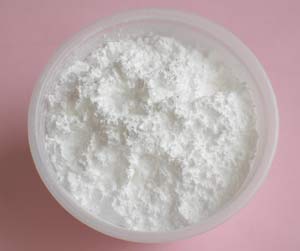An Interview with Dr. Dana Myatt, NMD ( Focus on Allergy Research, April 2013)
Note: Magnesium stearate, a common “inactive” ingredient in many nutritional supplements, has been critiqued by several nutritional supplement companies and physicians online. It has been compared to chalk, said to impair absorption of nutrients, to form a harmful “biofilm” in the intestines, and even to suppress immune function. Since magnesium stearate is an important flow agent that is widely used in the nutritional industry, we felt it important to carefully examine these claims. We found that they were all baseless. After watching a thorough, highly credible and scientifically referenced video by Dr. Dana Myatt on magnesium stearate, available at https://www.youtube.com/watch?v=Fx_ISfVVGuQ, we invited her to a question and answer session with Focus. – Stephen Levine, PhD
Focus: What exactly is magnesium stearate and what is its role in nutritional supplements?
 Myatt: Magnesium stearate is a simple salt made of two common nutritional substances, the mineral magnesium and the saturated fat stearic acid. It is used as a “flow agent” in many nutritional supplements and pharmaceuticals. Magnesium stearate contains two molecules of stearic acid and one molecule of magnesium. The molecule is held together by ionic bonds — the definition of a salt — that break apart easily in acid, the condition found in the human stomach. Though the name may make it sound like a synthetic, space-age molecule, both magnesium and stearic acid are abundantly available in many foods in our diet. In order to really understand magnesium stearate, let’s look at its two components.
Myatt: Magnesium stearate is a simple salt made of two common nutritional substances, the mineral magnesium and the saturated fat stearic acid. It is used as a “flow agent” in many nutritional supplements and pharmaceuticals. Magnesium stearate contains two molecules of stearic acid and one molecule of magnesium. The molecule is held together by ionic bonds — the definition of a salt — that break apart easily in acid, the condition found in the human stomach. Though the name may make it sound like a synthetic, space-age molecule, both magnesium and stearic acid are abundantly available in many foods in our diet. In order to really understand magnesium stearate, let’s look at its two components.
Magnesium is an essential mineral, the major mineral most likely to be deficient in the American diet. (1) I don’t think anyone would argue the safety of magnesium.
Stearic acid is a saturated fatty acid found in many foods including eggs, chicken, grass-fed beef, coconut oil, walnuts, cheese, chocolate, salmon and human breast milk, to name just a few. (2)
Both magnesium and stearic acid are not only safe, they are beneficial to human health.
Magnesium stearate is simply a salt that combines both of these molecules.
Focus: Magnesium stearate is used as a flow agent in countless nutritional supplements. What is a “flow agent” and why is it necessary?
Myatt: Flow agents help ensure a consistent dose of product in each capsule. Magnesium stearate does this by preventing individual ingredients from sticking to each other and from sticking to the encapsulating machines. It allows manufacturers to create a consistently homogenous mix, so the amount of active ingredients is the same from capsule to capsule or tablet to tablet. In other words, the use of magnesium stearate and other flow agents helps ensure consistency and quality control.
Focus: Some companies claim that they do not use flow agents or other “inert ingredients.” Is that a good thing?
Myatt: This might sound good to consumers who do not understand the nuances of good supplement manufacturing practices. The truth, however, is that companies that don’t use flow agents are more likely to have inconsistent doses of ingredients in each capsule or tablet. Almost all drugs and supplements contain inactive ingredients. These “inactives” serve multiple purposes. Flow agents, as we discussed, help ensure consistent dosing in each tablet or capsule. Some products contain fillers like cellulose which acts as a binder in tablets and helps fill out the size of tablets or capsules. Herbs can be encapsulated and additional herb used as filler, so these products may contain only “actives.” So yes, it is possible to make capsules or tablets without inactive ingredients, but quality control becomes more difficult.
Focus: We have seen claims on the internet, on videos, that magnesium stearate suppresses immune T-cell function and causes the collapse of cell membrane integrity in helper T-cells. Is there any scientific support for this?
Myatt: Not unless you’re a mouse.
Focus: Not unless you’re a mouse?
Myatt: This claim about immune suppression is based on the gross misrepresentation of a single mouse study. Here’s the “Cliff notes”:
The entire claim is based on a single study — that’s right, one study — performed in 1990, using mouse T-cells in a Petri dish. When mouse T-cells were incubated (read that as: “soaked”) with stearic acid — not magnesium stearate, but stearic acid —there was indeed a collapse of the cell membrane and a loss of T-cell function. (3) This study was never repeated.
But here’s the factoid that magnesium stearate naysayers conveniently “forget” to mention. Mouse t-cells are known to lack the delta-9 desaturase enzyme that converts stearic acid into the perfectly healthy fat, oleic acid. This was mentioned right in the same mouse-cell study. Mouse T-cells can apparently become toxic from high levels of stearic acid, at least in a Petri dish and at levels far above what could ordinarily be achieved from diet. That has nothing to do with humans. Human T-cells have the delta-9 desaturase enzyme that converts stearic acid to oleic acid, so human T-cells don’t develop any toxic build-up when exposed to stearic acid.4
Bottom line: Mice lack an enzyme in their T-cells that humans have, so stearic acid is toxic to mouse T-cells and not to human T-cells.
Focus: What about the difference between stearic acid and stearate?
Myatt: Stearic acid is one of the most common saturated fatty acids found in nature. (5) The term “stearate” is used when stearic acid is part of a salt (as when stearic acid combines with magnesium to form magnesium stearate). The terms stearic acid and stearate can be used interchangeably.
Focus: How much stearic acid is generally contained in supplements?
Myatt:
- The daily adult intake of stearic acid from food (US adult) averages about 7,000 mg/day. (6)
- A person taking 20 vitamin capsules weighing 500 mg each and containing 1% magnesium stearate would take in less than 96 mg of stearic acid per day. Manufacturers typically use 0.25% – 5% magnesium stearate in nutritional formulations.
- The amount of stearic acid from supplements in the above scenario is 1.3% of the total daily adult intake.
- Four ounces of human breast milk contains more than 5,000 mg of stearic acid. A 2-ounce chocolate bar will also provide well over 5,000 mg of stearic acid.
- Magnesium stearate is considered safe for human consumption at levels below 2,500 mg/kg per day. This equates to 170,000 mg per day as a safe dose for a 150-pound adult. (7) That’s almost 6 ounces of pure magnesium stearate.
Focus: One claim we’ve seen is that the addition of magnesium stearate to supplements decreases bioavailability. Another claim is that magnesium stearate is a chalklike substance that gums up your intestines and prevents absorption of your nutrients. Fact or fiction?
Myatt: What the studies actually show is that absorption might be slowed somewhat but overall absorption is not decreased. (8,9) And magnesium stearate is definitely not a chalk. Chalks are soft, stone-like minerals, including things like gypsum (calcium sulfate) CaCO3 (calcium carbonate) and CaO (calcium oxide). Remember that magnesium stearate is a salt, containing approximately 96% stearic acid, which is a saturated fat. The other 4% is magnesium. Chalks are combinations of minerals, but magnesium stearate is mostly saturated fat. How could a fat be a chalk? It isn’t, not by any known scientific definition of a chalk.
Even if it were a chalk, you shouldn’t be worried about it gumming up your intestines or “caking the lining.” Why? Because if you did eat chalk, like calcium carbonate, which is a form of calcium used in many nutritional supplements, your digestive system would break it down to its mineral components. Human digestion is truly amazing.
By the way, I used to perform quite a few endoscopies in clinic. This is where you examine the lining of the large intestine with a special scope, looking for polyps. I never once saw anyone with a “caking of the lining” of their intestinal tract. Tenacious, dry stool sometimes, yes. But “caking” with a chalk-like substance? Never. If this story about “caking the lining” is told by a doctor, it must be one who has never actually visualized the inside of the large intestine.
Focus: No T-cell collapse in humans, no “caking of the lining” of intestines. How about the claim that magnesium stearate stimulates the gut to form a biofilm? And that a biofilm is equivalent to a sludge that would act as a barrier to the absorption of nutrients?
Myatt: There is not one single scientific reference or study to support this claim. In fact, if you know what a biofilm is you’ll see that this entire argument is completely preposterous. It has no basis in any known science.
To clarify for those readers who haven’t seen it, there was an internet video by a well-known doctor that said that a biofilm is basically like the “sludge in your toilet tank,” and that magnesium stearate causes this sludge and prevents nutrient absorption.
Just as there is a big difference between a chalk and a fat, a biofilm is not akin to sludge, or a “soap scum” that you might find in your bathtub (a toilet tank just holds water and won’t even form a soap scum ring). A bathtub ring occurs when hard water, containing calcium or magnesium, reacts with fatty acid in soap to form so-called “soap scum.” If you live in a hard-water area, you’ll see this as an annoying white film on your shower curtain. Humans get significant amounts of magnesium, calcium and fatty acids — the ingredients in soap scum — from diet. But we don’t form soap scums in our bodies because of our digestive enzymes and acids.
Further, soap scum is not biofilm — not even close.
Biofilms are layers of bacteria or yeast embedded in the gel-like substance they secrete. They tend to be highly antibiotic-resistant. As to the claim that stearic acid causes biofilms, this is completely without any scientific evidence. In fact, several studies have shown just the opposite — stearic acid actually helps prevent the formation of biofilms. (10,11)
Focus: Next claim. Magnesium stearate is made from contaminated oils from genetically engineered crops. True?
Myatt: Magnesium stearate is most commonly sourced from cottonseed oil or palm oil and it’s true that cotton can be a GMO crop and is typically high in pesticides. But even if the starting cottonseed oil is contaminated, the finished product, stearic acid, is so highly purified that contamination really isn’t an issue. Cottonseed-derived stearic acid is so purified and the final molecule so far-removed from the original source, it doesn’t carry any pesticide residue. We might as well worry about the food-grade additive cellulose, which is also obtained either from wood waste (we call that “sawdust” out here in Arizona) or cotton waste (known as “gin trash,” — the waste cotton remaining in the cotton gin). (12) Just like taking dirty water and purifying it into something clean and drinkable, purifying cottonseed oil to obtain stearic acid delivers a pure finished product. And by the way, stearic acid can also be derived from palm oil, which many manufacturers use as the source of their stearic acid.
Focus: Is magnesium stearate often contaminated during processing, as one doctor claims?
Myatt: Contamination during the manufacture of supplements or pharmaceuticals can occur anywhere along the entire manufacturing process. That is why quality supplement manufacturers test raw materials upon purchase; during manufacturing, processing, and also test the final product. Raw materials can occasionally become cross contaminated, and that’s why quality manufacturers employ so many tests and inspections all along the process.
Now, is magnesium stearate one of the substances more likely to be contaminated? Absolutely not. There is one reported instance of a raw materials manufacturer notifying the World Health Organization that several batches of magnesium stearate had been cross contaminated with zeolite (sodium aluminum silicate), calcium hydroxide, and several other substances. The contamination was determined to be due to incomplete cleaning of air milling equipment. This was traced to a single raw materials manufacturer and was an isolated event. Moreover, WHO found the contaminating substances to be present in such minute amounts that they posed no health risk. And this was self-reported by the manufacturer of the raw material before it was used in product. (13)
Focus: Is magnesium stearate going to be removed from supplements by the Codex Committee on Food Additives?
Myatt: No. The Codex Committee considered removing magnesium stearate from the acceptable food list, not because of any danger, but because they didn’t see the use for it in food. They were simply trying to trim up their list of allowed food additives. When food manufacturers pointed out that magnesium stearate is an important and safe anti-caking agent, it was reinstated. Removing magnesium stearate from Codex for use in nutritional supplements has never been considered as far as I can determine.
Magnesium stearate is currently approved by FDA regulations for use in food and supplements. (14)
Focus: You’ve done a brilliant job of going back to the actual peer review science and dismantling every specious claim about magnesium stearate. Any final thoughts?
Myatt: I don’t always agree with my colleagues in the nutritional supplement industry. Some ingredients and doses based on the scientific literature are arguable. With most issues in medicine, there is no black and white. There is instead, “ten thousand shades of gray.” In many instances, there is evidence on both sides of the question.
But the evidence is not “mixed” on the safety of magnesium stearate. The evidence says that magnesium stearate, a simple salt of magnesium and stearic acid, is a safe and effective flow agent that helps maintain dose consistency, and there really isn’t any evidence to the contrary. At least I haven’t found any, and I’ve looked long and hard at these claims because I, too, manufacture nutritional supplements and use magnesium stearate as a flow agent. So I had to know if any of these claims had even a shred of basis in fact. They don’t.
Right now, the damning claims for magnesium stearate are completely without scientific verification or substantiation.
References:
1. National Institutes of Health, Office of Dietary Supplements: Magnesium. http://ods.od.nih.gov/factsheets/Magnesium-HealthProfessional/
2. USDA National Nutrient Database for Standard Reference, Release 24.
3. Tebbey PW, Buttke TM. Molecular basis for the immunosuppressive action of stearic acid on T cells. Immunology. 1990 Jul;70(3):379-84. PMID: 2379942
4. Anel A, Naval J, González B, Uriel J, Piñeiro A. Fatty acid metabolism in human lymphocytes. II. Activation of fatty acid desaturase-elongase systems during blastic transformation. Biochim Biophys Acta. 1990 Jun 14;1044(3):332-9. PMID: 2114179
5. U.S. Department of Agriculture, Agricultural Research Service. What we eat in America, NHANES 2001-2002, individuals 2 years and over (excluding breast-fed children). www.ars. usda.gov/SP2UserFiles/Place/12355000/pdf/ Table_1_BIA.pdf, page 5. Accessed 06/28/12
6. Søndergaard D, Meyer O, Würtzen G. Magnesium stearate given perorally to rats. A short term study.Toxicology. 1980;17(1):51-5. PMID: 7434368
7. Alija Uzunović, Edina Vranić. Effect Of Magnesium Stearate Concentration On Dissolution Properties Of Ranitidine Hydrochloride Coated Tablets. Bosn J Basic Med Sci. 2007 Aug;7(3):279-83. PMID: 17848158
8. Eddington ND, Ashraf M, Augsburger LL, Leslie JL, Fossler MJ, Lesko LJ, Shah VP, Rekhi GS. Identification of formulation and manufacturing variables that influence in vitro dissolution and in vivo bioavailability of propranolol hydrochloride tablets. Pharm Dev Technol. 1998 Nov;3(4):535- 47. PMID: 9834957
9. Soni KA, Jesudhasan P, Cepeda M, Widmer K, Jayaprakasha GK, Patil BS, Hume ME, Pillai SD. Identification of ground beef-derived fatty acid inhibitors of autoinducer-2-based cell signaling. J Food Prot. 2008 Jan;71(1):134-8. PMID: 18236673
10. Liaw SJ, Lai HC, Wang WB. Modulation of swarming and virulence by fatty acids through the RsbA protein in Proteus mirabilis. Infect Immun. 2004 Dec;72(12):6836-45. PMID: 15557604
11. USDA. Cellulose. www.ams.usda.gov/ AMSv1.0/getfile?dDocName=STELPRDC5066975
12. World Health Organization Quality of Medicines for Everyone, Contaminated magnesium stearate VG EP excipient manufactured by Ferro, supplied by Signet and used in finished pharmaceutical products, December 22, 2011. http://apps.who.int/ prequal/info_press/documents/Mg-Stearate_ InformationNote_Dec2011.pdf
13. Food and Drug Administration, CFR – Code of Federal Regulations Title 21, accessed Sept. 10, 2012. http://www.accessdata.fda. gov/scripts/cdrh/cfdocs/cfcfr/CFRSearch. cfm?fr=172.863&SearchTerm=salts%20of%20 fatty%20acids
14. Food and Drug Administration, Select Committee on GRAS Substances (SCOGS) Opinion: Magnesium stearate, accessed Sept. 10, 2012. www.fda.gov/Food/FoodIngredientsPackaging/ GenerallyRecognizedasSafeGRAS/ GRASSubstancesSCOGSDatabase/ucm260466.htm
Dr. Dana Myatt is a graduate of the National College of Naturopathic Medicine and has been in multi- disciplinary, full-scope family practice for 23 years. She is the founder and CEO of Myatt Nutritionals and is author of “A Physician’s Diary” (A.R.E. Press, 1994) and the upcoming “Ketone Zone Diet.” She is a member of The American Association of Naturopathic Physicians, the Arizona Naturopathic Medical Association, the American Academy of Anti-Aging Medicine and the American Society for Reproductive Medicine.















[…] you might be wondering why Magnesium Stearate is one of the key ingredients of this supplement. The reason is that Magnesium is one of the key […]
[…] Magnesium Stearate […]
[…] Inglés J. (2013). Estearato de magnesio: un relleno seguro y efectivo que pone las cosas en claro. nutritionreview.org/2013/11/magnesium-stearate-a-safe-and-effective-filler-setting-the-record-straig… […]
[…] compound used to produce many pills or capsules in the pharmaceutical industry. It is regarded as generally safe by health […]
[…] compound used to produce many pills or capsules in the pharmaceutical industry. It is regarded as generally safe by health […]
[…] is used mainly as a filler or to help stabilize some components. It is regarded as generally safe for consumption. Gelatin – Gelatin is also used in the production of the capsule of this […]
[…] All of these are absolutely harmless and okay to use long-term. I mean you can get something like an unpleasant feel or smell in the mouth from Gelatin but other than that it’s amazingly beneficial. Or you might get confused about Magnesium Stearate as it’s hugely controversial but at the end of the day, no worries, it’s harmless [R, R, R, R, R]. […]
[…] The former is a polysaccharide extremely common in nature, and we consume tons of it with fruits and vegetables. The latter is a highly misunderstood but actually harmless substance which is something that also the minority of high-profile health experts and doctors agree with [R, R, R, R, R, R, R, R]. […]
[…] Proper understanding of the available research will leave us where the minority of high-profile doctors are landing with this one. Meaning, the Stearic Acid in the Magnesium Stearate is actually not harmful at all due to the specific characteristics when it comes to human biochemistry [R, R, R, R, R]. […]